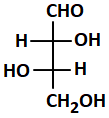Select Chapter Topics:
If a Sugar ' X ' is found in honey, is a keto sugar, exists in \(\alpha\) and \(\beta\) - anomeric forms and is laevorotatory, then find out 'X':
1. Maltose
2. Sucrose
3. D-Glucose
4. D-Fructose
1. Maltose
2. Sucrose
3. D-Glucose
4. D-Fructose
Subtopic: Carbohydrates - Classification & D-L configuration |
58%
Level 3: 35%-60%
NEET - 2025
Please attempt this question first.
Hints
Please attempt this question first.
Match List-I with List-II.
Choose the correct answer from the options given below:
1. A-II, B-III, C-I, D-IV
2. A-IV, B-III, C-II, D-I
3. A-I, B-III, C-II, D-IV
4. A-IV, B-III, C-I, D-II
| List-I (Name of Vitamin) |
List-II (Deficiency disease) |
||
| A. | Vitamin \(B_{12}\) | I. | Cheilosis |
| B. | Vitamin \(D\) | II. | Convulsions |
| C. | Vitamin \(B_{2}\) | III. | Rickets |
| D. | Vitamin \(B_{6}\) | IV. | Pernicious anaemia |
Choose the correct answer from the options given below:
1. A-II, B-III, C-I, D-IV
2. A-IV, B-III, C-II, D-I
3. A-I, B-III, C-II, D-IV
4. A-IV, B-III, C-I, D-II
Subtopic: Vitamins, Hormones & Enzymes |
57%
Level 3: 35%-60%
NEET - 2025
Please attempt this question first.
Hints
Please attempt this question first.
The reagents with which glucose does not react to give the corresponding test/products are:
A. Tollen's reagent
B. Schiff's reagent
C. \(\text{HCN}\)
D. \(\text{NH}_2\text{OH}\)
E. \(\text{NaHSO}_3\)
Choose the correct option:
A. Tollen's reagent
B. Schiff's reagent
C. \(\text{HCN}\)
D. \(\text{NH}_2\text{OH}\)
E. \(\text{NaHSO}_3\)
Choose the correct option:
| 1. | \(\text{A}\) and \(\text{D}\) | 2. | \(\text{B}\) and \(\text{E}\) |
| 3. | \(\text{E}\) and \(\text{D}\) | 4. | \(\text{B}\) and \(\text{C}\) |
Subtopic: Carbohydrates - Classification & D-L configuration |
71%
Level 2: 60%+
NEET - 2024
Hints
Match List-II with List-II :
Choose the correct answer from the options given below:
1. A-I, B-II, C-III, D-IV
2. A-IV, B-III, C-II, D-I
3. A-I, B-IV, C-II, D-III
4. A-IV, B-I, C-II, D-III
| List-I (Vitamins) | List-II (Deficiency/other name/ property) | ||
| A. | Vitamin K | I. | RBC deficient in haemoglobin |
| B. | Vitamin \(\text{B}_{12}\) | II. | Bleeding gums |
| C. | Vitamin C | III. | Thiamine |
| D. | Vitamin \(\text{B}_1\) | IV. | Fat soluble |
1. A-I, B-II, C-III, D-IV
2. A-IV, B-III, C-II, D-I
3. A-I, B-IV, C-II, D-III
4. A-IV, B-I, C-II, D-III
Subtopic: Vitamins, Hormones & Enzymes |
80%
Level 1: 80%+
NEET - 2024
Hints
Given below are two statements:
In the light of the above statements, choose the correct answer from the options given below:
| Statement I: | Glycogen is similar to amylose in its structure. |
| Statement II: | Glycogen is found in yeast and fungi also. |
| 1. | Statement I is correct and Statement II is incorrect. |
| 2. | Statement I is incorrect and Statement II is correct. |
| 3. | Both Statement I and Statement II are correct. |
| 4. | Both Statement I and Statement II are incorrect. |
Subtopic: Polysaccharides & their Importance |
51%
Level 3: 35%-60%
NEET - 2024
Hints
Given below are two statements:
In the light of the above statements choose the correct answer from the options given below:
| Statement I: | A unit formed by the attachment of a base to 1' position of sugar is known as a nucleoside. |
| Statement II: | When nucleoside is linked to phosphorous acid at 5' position of sugar moiety, we get nucleotide. |
| 1. | Statement I is false but Statement II is true. |
| 2. | Both Statement I and Statement II are true. |
| 3. | Both Statement I and Statement II are false. |
| 4. | Statement I is true but Statement II is false. |
Subtopic: DNA, RNA & Metal Ions |
Level 4: Below 35%
NEET - 2023
Hints
Cheilosis occurs due to the deficiency of:
| 1. | Thiamine | 2. | Nicotinamide |
| 3. | Pyridoxamine | 4. | Riboflavin |
Subtopic: Vitamins, Hormones & Enzymes |
70%
Level 2: 60%+
NEET - 2023
Hints
Which one is not a D-sugar:
| 1. |  |
2. |  |
| 3. |  |
4. |  |
Subtopic: Carbohydrates - Classification & D-L configuration |
70%
Level 2: 60%+
NEET - 2022
Hints
The incorrect statement about the denaturation of proteins is:
| 1. | It results due to change of temperature and pH. |
| 2. | It results in the loss of biological activity of proteins. |
| 3. | A protein is formed from amino acids linked by peptide bonds. |
| 4. | Uncoiling of the helical structure takes place. |
Subtopic: Denaturation of Proteins & Chemical Properties |
68%
Level 2: 60%+
NEET - 2022
Hints
The RBC deficiency is a deficiency disease of:
| 1. | Vitamin B1 | 2. | Vitamin B2 |
| 3. | Vitamin B12 | 4. | Vitamin B6 |
Subtopic: Vitamins, Hormones & Enzymes |
87%
Level 1: 80%+
NEET - 2021
Hints






